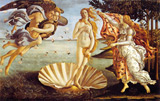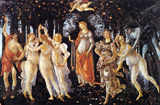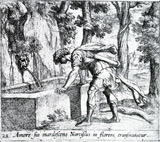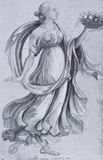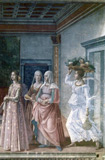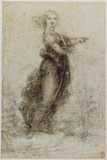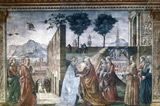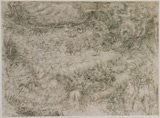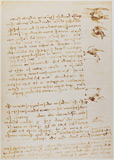IMAGES No. 1
Realities in pictures: body, movement, culture
- Barbara Baert: Wind—On a Pictorial Quintessence
- Souzana Mizan: The Enemy Renarrated: Beyond Culture Clash
- Marijan Krivak: Against the Media – The Media of Resistance
- Petra Krpan: The disintegration of body: contemporary fashion and new media
- Mirela Ramljak Purgar: The influence of film on the “Brücke” group printmaking
- James Elkins: Images as Arguments in Visual Studies
Wind—On a Pictorial Quintessence
Like a leaf clings to a tree1
Abstract
The wind only allows itself to be seen indirectly: swaying trees, waving grass, fluttering textile. Yet we can feel the wind. And hear it. Wind brings scents. Wind is a cosmic breath. Wind binds and drives apart. Wind nourishes or destroys. For all these reasons and more, wind embodies a hermeneutics of the association between freedom and attachment, between the unexpected and fate. But is there such a thing as an iconography of this caprice? How are we to understand the representation, evocation and suggestion of wind? How does one contain pictorially this natural phenomenon that envelops and penetrates us? And is wind in the visual arts a motif or rather a formal affect?
The representation, evocation and suggestion of wind in the visual arts touches on fundamental ideas relating to the anthropology of the senses and their descent into the visual medium. Wind is a natural phenomenon that plays on the entire sensorium of the body. Wind is tactile. Wind can be heard. Wind carries scents. Wind is a cosmic breath that envelops and penetrates us. Wind nourishes or destroys. Even our own bodies produce and inhale wind. The wind is related to the breath that exits and enters our bodies, even to the gases our organs emit. Wind is both the lower – the anal eruption – and the higher – the oral air we need. There is also a third “wind” in our body. In the Greek philosophy of Aristotle (384-322 BC), the concept of pneuma is central to both breath and spirit. It is the vital energy of life, literally, the “gas” that occupies the brain and is responsible for thought, perception and movement. One receives this vital energy at birth and refereshes it continually by drawing breath.
Wind and hermeneutics
In the history of Greek culture there are five terms for wind, including derivatives from “air” and “breath”: aer, aither, pneuma, phusa and anemos. 2 Anemos is the term for the four winds and refers to the four cardinal directions: Euros (East), Notos (South), Zephyros (West) and Boreas (North) (fig. 1). Of these winds it was said that they were endowed with the power of sex and the ability to “impregnate” living beings. Phusa (phusao, to blow) is a term leading to the wind instruments, but also to the crater of a volcano. The term Pneuma (breath or air) was extended to spirit, inspiration. Aither and aer are related to mist and the open air, respectively. The pneuma in the body is phusa. The pneuma outside the body is aer (air). Pneuma is thus the genus from which phusa splits off for breath and aer for air.
The wind is also mentioned in Ezekiel 37:9, but without being named as such.3 Since early Christian times the wind has been depicted as a winged youth, and hence related to the angels (fig. 2).4 They are often seen blowing horns. The representation of the four winds in Christianity is part of its cosmology. The Genesis embroidery of Girona (ca. 1050) shows the four winds in its four corners (fig. 3).5 They blow in the direction of the concentrically arranged story of creation. The winds not only accompany creation, they also make creation possible and enable it to perpetuate itself. The wind symbolizes the four axes of the world (and hence the cross); they are the bearers of the quaternitas, such as the four temperaments, the four evangelists and so on (fig. 4). As regenerative archetypes for the cosmos, the four winds also pass through humanity. The breathing individual is impregnated by wind, made by wind, thereby making the wind a mediator between macrocosm and microcosm.
Modeled after a cosmic force that weeps, rejects and loves, wind is a principle that can never be held entirely in check. This uncontrollable force is moreover one of the keys to animism, in which wind acts upon nature as a wild, living affect. Wind brings to life that which is “still.” Wind touches our skin sensually, but can also be merciless, destroying entire harvests at one blow. Wind adheres to the phantasmal, the automatic and the demonic. From thence comes its involvement in the auricular symbolism of the voice, the spirits and musical instruments.
Wind joins, flows, links, changes direction – in short, the wind is capricious. In its capriciousness wind embodies a particular hermeneutics of association, of freedom and the unexpected. Is an iconography of this capriciousness possible? How does one capture in pictorial form this natural phenomenon that envelops and penetrates us, even escapes from our own bodies? The dynamics of wind are after all only indirectly visible: swaying trees, waving grass, fluttering textile. How has wind impregnated the theory of the image? Is it a question of visual pneuma? And is wind in the arts a question of content, or rather a matter of formal affect? To answer these questions I begin with the mystery of mysteries: the impregnation of the image in the womb of a virgin.
Annunciation
Luke 1:28-35 says: “And he [Gabriel] came to her and said, ‘Greetings, favored one! The Lord is with you.’ But she was much perplexed by his words and pondered what sort of greeting this might be. The angel said to her, ‘Do not be afraid, Mary, for you have found favor with God. And now, you will conceive in your womb and bear a son, and you will name him Jesus. He will be great, and will be called the Son of the Most High, and the Lord God will give to him the throne of his ancestor David. He will reign over the house of Jacob forever, and of his kingdom there will be no end.’ Mary said to the angel, ‘How can this be, since I am a virgin?’ The angel said to her, ‘The Holy Spirit will come upon you, and the power of the Most High will overshadow you; therefore the child to be born will be holy; he will be called the Son of God.’”
Since the origin of this theme in the early Christian period, a particular energy shimmers through the iconography of the Annunciation with respect to the legitimation of the culture of the image (fig. 5). Is not the mystery of God’s incarnation precisely the emanation of an invisible visage in the visibility of the Son? And is this emanation not analogous to that other mystery: the possibility of expressing the divine artistically, tracing it in line and color, in the world of time and space? For this reason the Annunciation is more than just the iconography of a biblical passage: it thematizes and comments upon the beginning of the figurative process – the incarnation and thus the “becoming image” of Christ. In short, the Annunciation is about the unnamable secret of the visual self. Artists have felt this secret to varying degrees and in accordance with their Zeitgeist exercised pictorial means to bring this deepest of cores to the artistic surface. The mystery of conception is after all a great challenge to depict by pictorial means alone. Where, and exactly when did it take place?
The answers to these questions bring deeper layers of the archetype “wind” to the surface.
“How can this be?” This question in the gospel of Luke has been a source of fascination since patristic times. By what path will the impregnation of the Virgin by the Holy Spirit take place? Through the shadow of the Most High, as in the angel’s reply? Is that sufficient? The Latin Church brought forth something else; namely, the “acoustic metaphor.”6 Eve allowed herself to be seduced by the dark words of the serpent, while Mary surrendered her ear to another, golden power of persuasion. The power of the word, received in the ear canal, was quickly described in plastic terms. “O blessed virgin, become mother without the agency of a man. Because her ear was the wife, and the words of the angel the husband,” says Eleutherius of Tournai sometime around the year 500.7 Or later, in the Carolingian period, Agobard of Lyon (†816): “He, the light, the divine creator of the universe, descends from heaven, sent forth from the breast of the Father (missus ab arce patris)8; wrapped in a purple stole, and enters through the ear of the Virgin, and leaves by the golden door.”9
That the voice can lead to fertility through the ear canal has to do with the underlying idea of impregnating “breath”: the Greek pneuma or Hebrew ruakh, which also means wind. In the Annunciation we often see that the dove, image of the Holy Spirit, is placed near Mary’s ear (usually the right ear), and from this position breathes in the beginnings of life.
Taking as his point of departure the classic iconography of the Annunciation, in which the dove often emerges from the mouth of the Father, supported by a golden ray of light, Ernest Jones goes further into what he considers in essence to be the emanation of the wind archetype in his anthology Applied Psycho-Analysis (fig. 6).10 The stem of wind goes back to various semantic fields: “gold” (that is, radiance), “ear canal” (sound) and “dove” (bird/flight), with special derivatives such as the sense governed by the tongue (speech), the mouth (breath), scent and moisture. Why is regenerative material represented as something that comes out of the mouth – more specifically, as breath? Why must the ear be the receptive organ? And why does a dove accompany this principle?11
The mouth is feminine, receptive, but as the producer of saliva and breath, which moreover contains a tongue and is able to spit, it becomes a masculine organ. That breath is a life-generating organ is evident from the story of creation, in which God breathes life into Adam’s nostrils (Gen 2:7) (fig. 7).12 In the Koran the angel Gariel “breathes” on Mary’s abdomen, whereby she becomes pregnant. That living breath can serve as an agent of impregnation has to do with the characteristics of the air that passes in and out of our bodies: blowing like the wind, generating movement, sound, invisibility, moisture and warmth. Hera was impregnated by the wind and bore Hephaistos.13 Ovid (43 BC-17 AD) describes how Flora was raped by Zephyrus.14 Aristotle and Pliny the Elder (23-79 BC) assure us that partridges can become pregnant by means of the wind if a male stands opposite a female. Augustine (354-430) is certain that the seas of Cappadocia are fertilized by the wind. And in Tyrol it is believed that the east wind makes the penis shorter, while the west wind has a humid, fertilizing effect, just like Föhnfieber in Switzerland.15
The combination of these semantic traits, with their ancient ramifications in anthropology, has charged breath and wind with a capacity that they still demonstrate in the Annunciation.
Sublimation
Wind is rarely still. The sound of the wind is the sound of the power of nature itself. The sound of the wind is attributed to God (Ezekiel 3:12). It is not for nothing that the fiery tongues of Pentecost were preceded by a sound from heaven like a thundering power (Acts 2:2). The association between God and wind in the form of sound occurs in nearly all religions, even the Greek, in which the roaring voice of the wind is heard from Zeus. The divine voice of the wind is imitated by ritual elements. Archaic Dionysian instruments that produced a surprising wind-like sound by spinning are a good example. Like the didgeridoos of the Aboriginals, but also like the humming top, they mimic the singsong power of the primal wind. This type of musical instrument is ritually geared toward the veneration of the ancestors, often coupled with the sexual symbolism of thunder and lightning. The “primitive” effect of shouting before or during copulation also occurs among animals. And does not the lioness roar her cubs to life?
The roaring wind of the father is in fact a prefiguration of a more sophisticated offshoot: speech through the voice. In Genesis God “speaks” things to life. Speech – the Word – in Christianity was born of God’s breath and only afterward nestled itself in flesh. “In the beginning was the Word, and the Word was with God” (Joh 1:1). St Zeno of Verona (300-371) says that the uterus of Mary became swollen not from semen but from words. The invisibility and immateriality of the breath, of speaking, is the etymological core of many words that would later flow into the meaning of spirit, thought and brain.16 This process is clearly evident in Greek psyche, Hebrew nepesh, German Geist and English ghost: all words that are semantically rooted in “breath.”17 This explains the wealth of the pneuma concept, which simultaneously means wind, breath and spirit. In short, from the lowing wind to the impregnating wind, the foundation has been laid for a power that can impregnate the human body.
The other characteristic of wind, humidity, is reflected in uterine fluids, urine, sweat and semen. The wind-breath-spirit complex is often paired with fluidity, as in Christian baptism, in which water and spirit together have a purifying effect. A primitive image of impregnation is the combination of the vapors of wind and water. The result is steam, which not only lends fertility to the genitals but also to the brain, given the glossolalia of the Greek sibyls at the steam baths. The humid breath from the mouth, with its red tongue functioning as a moisture emitting “rod,” has been compared to the element fire, the fiery tongues of Pentecost being an equivalent of the descending breath/spirit/pneuma (fig. 8). The wind fans the flames but blowing on holy fire is taboo. Nevertheless there is one invisible element that passes noiselessly and easily from water to fire, from fire to air and from air to earth, and that is scent, the most invisible emanation of the wind archetype.18 In the Annunciation scent hides behind vegetative symbolism, the most important convention of which is the lily as a sign of virginity. The lily is often placed in the center of the composition (fig. 9). It divides the world above from the receptive domestic room.19 If the lily is the marker of both worlds, yea, is the materialization of that imaginary threshold, then scent is the medium of “transgression” between two worlds.
According to Ernest Jones we are back at the starting point, at which breathing through the lower body formed the phantasmagorical model for the chain of associations sketched above. There is a question of dematerializing the bodily “winds” with their scents, sounds, humidity and warmth and turning them into the impregnating breath of God expressed as golden rays as the final form of the sublimation process.
Sensorium
In Le Détail Daniel Arasse (1944-2003) draws our attention to an Annunciation by Filippo Lippi (1406-1469), in which a buttonhole without a button has been painted over the Virgin’s navel (fig. 10).20 This tiny opening is almost invisible to the naked eye. Arasse studies several details in his book that are scarcely visible; as such – according to the author – they must be viewed as the enigmatic and intimate intertwining of the painter and his art. Hence the specific positioning of this particular lost button must also have some symbolic meaning.21
Tiny golden rays radiate outward from the scarcely visible hole, echoing the rays of light from the beak of the dove. The golden rays are the impregnating “breath,” the glow of conception drawing together. This would mean that Lippi suggests that light from the Word-become-flesh was already escaping from the womb. On the other hand, this double radiation also corresponds to 15th-century notions concerning optics: sight arises from physical radiation from the eye as well as from the object. The scientific law of what sight is (and hence painting) also becomes the law of what conception is (and hence incarnation). The painting of the Renaissance – concerned with the application of mimesis and optical correctness, but not therefore averse to symbolic layering in the laws themselves – presents itself as an incarnation and vice versa. In this way painting suppresses the sonorous sense in favor of light and sight. The strange consequence is that the opening above the navel, blind and therefore visionary, presents itself as an interior view, endoscopic and uterine. The closed opening that is the navel is the scar of the indefinable: fetal life within the mother.
Filippo Lippi’s detail of the navel may have been a virtuoso refinement of an earlier Tuscan tradition. On the retable of Gentile da Fabriano (ca. 1421-1425) a ray of light escapes from the breast of God, entering Mary’s room through the round window above and ending just under her heart, where the six-lobed oculus is projected like a transparency across her lower body (fig. 11). The “eye” of Mary’s room is repeated like an optical photogram: she bears the divine light of a supernatural impregnation in a way that is thoroughly pictorial. Light has descended into painterly virtuosity: the subtle golden rays, the hidden energy of the dove and the optical echo of the window frame on textile. This also makes Mary’s abdomen into a sort of “receiving eye” of “windness.” Leo Steinberg describes this as a “connection between God and Mary that neutralizes the sensual through the fusion of a specific sensorium.”22 A higher synesthesia is thereby created: light that speaks, rays that evoke sound, the voice of God that sees, the womb that receives and at the same time “looks,” while Mary in turn looks up at the oculus in her room.23
But there is more. In Lippi’s painting, almost at the boundary of the invisible, the dove can be seen to move gradually over subtle, circular displacements of the air caused by wind. This unique and refined pictorial interpretation of wind, the quintessence, makes the dove more than a conventional guest in the painting, with his beak, golden rays and small cyclones, eye to eye with the navel. Where the angel is the messenger of God, the dove embodies the desire of God – more than that, it embodies the actual performance of this desire.24 But why a dove (kolumba)? That it must be a bird: fast, with a skittish, serpentine head, a phallic beak and genitals that cannot be seen (hermaphrodite), a singing, rustling animal like the wind, is easily explained. But the dove is more than that. According to Christian symbolism, the dove refers to the Church and the stages through which one must pass in order to achieve unity with God (fig. 12).25 Typologically it refers to the animal of the Old Testament that brought Noah’s twig. The twig-bearer is more than a messenger; it is the genius, the impregnator, the founder of a new generation.26 According to Pliny the dove is thus also a “seed-bearer”; the dove “scatters” the seeds of the mistletoe with its beak in the trees.27 Aristophanes says in his Omithes (birds) of 414 BC that kolumba/-is etymologically signifies “deep” or “diver,” given its concentric, “swimming” movements while in flight.28 This association involuntarily calls to mind the concentric displacements in Lippi’s painting, and imagines what is in fact taking place deep within Mary herself.
In the Annunciation the wind plays a role outside and inside. On the outside the wind is like the mouth or arca of God, like the descent of angels with fluttering garments, like the “swimming” doves, like word and speech from the mouth of Gabriel wound in radiant golden letters. The inside of the wind is the invisible wind: the reverse of pneuma. It is the wind that has impregnated, has flowed into the body and is thus able to create new life. The invisibility of conception and incarnation is externalized in motifs that embody deeper affects related to the displacement of air, breathing and impregnation. Painting these “invisible” motifs constitutes a challenge. Hence the breath becomes a bundle of golden rays, the displacement of air a transparent veil, word and speech are epigrams and Mary herself is – in the words of the Bible – overshadowed.29
Pathosformel
The presence of movement in the visual arts is subject to the shifting judgments of taste. The degree to which wind is more or less suggested in a composition, in nature and in the fall of the figures’ garments, can according to some authors be considered as marking off the boundaries between the major stylistic periods. In his Kunstgeschichtliche Grundbegriffe (1915) Heinrich Wölfflin (1864-1945) defends the pendulum motion of a constantly shifting formal language that shuttles between tectonic (closed) and a-tectonic (open) forms.30 The latter form is compressed energy, with a great deal of motion along the pictorial axes. In short, there are windless, closed and calm stylistic periods as opposed to stylistic periods that burst at the seams with movement. Within these broad outlines are undoubtedly a variety of aesthetic tastes. Johan Joachim Winckelmann (1717-1768), for example, sternly condemned the use of flamboyant drapery in sculpture and defended the beauty of the strict, static fall of folds like the flutes of a Doric column (fig. 13).31
In the history of art, however, one period – which is in fact limited to one generation – celebrates all the virtuoso aspects of the wind in art in a way that surpasses exuberance: fluttering garments, tossing trees, tresses flying. It is the Quattrocento generation of Sandro Botticelli (1445-1510), Filippo Lippi (1406-1465), Domenico Ghirlandaio (1449-1549) and Leonardo da Vinci (1452-1519).32 In his article Bewegende Bewegungen, Georges Didi-Huberman explores in more depth Aby Warburg’s (1866-1929) 1893 interpretation of Botticelli’s Venus and Primavera (fig. 14, fig. 15).33 Aby Warburg is entirely captivated by the “living motion” at the edges of the body. He speaks of an art fascinated by “moving side-effects.”34 The moving accessories spread the gaze, and in the near-impossible undertaking of consciously trying to follow so much dynamism, so much pleating – yea, so much wind – a capricious “wind vision” arises on the part of the viewer which seems to impregnate the subject anew, to breathe into it.35 An important Renaissance paradigm plays a part in this fertilizing gaze: ekphrasis. Ekphrasis, or the drive to make virtuoso copies of descriptions in Antique books, is so intense in this generation of painters that it even gives rise to pictorial anomalies. The pleats around the waist of the left Grace in Primavera seem to be caused by a belt that has not actually been painted.36 The answer is to be found in the writings of the Ancients. Lucius Annaeus Seneca (4-64) says that youthful femininity expresses itself in a “sheer unbelted garment” (fig. 16).37 The ekphrasis of Botticelli is linked to contemporary art-theoretical notions of “surface.” A theme, an historia, is according to Leoni Battista Alberti’s (1404-1472) De pictura the result of ordering superficies until membri are created, which in turn become corpora.38 In the case of Botticelli these surfaces are like Sehflüsse: transparent, painted with un-pigmented varnish directly on the membri (for example, on the clasped hands) and the corpora (legs, bellies, breasts), creating a formally perfect allegory of the grace of the three Graces.39 For Alberti, planes and bodies are the visible expression of an invisible “Behind.” And what is behind the body according to Alberti are the movements of the soul itself as the essence of painting. They are difficult to paint but form the challenge of falling drapery, among other things.40 The liveliness of the surfaces and movements of the fabric that express the movements of the soul exist thanks to “air” and “wind.” Wind is the medium in painting that introduces beauty and makes possible the soul of painting. Painting contains pneuma, the genus of internal and external air, which “animates” the subject.
Cennino Cennini (1370-1396) said that in fresco painting, the fall of drapery is crucial to producing relief and depth. He describes this artistic skill both in the context of textile as in the context of bodies of water. According to the author the supple qualities of garments can also be seen in the waves of water.41 This entails a particular pictorial fertilization between textile and water (fig. 17). 42 The fusion of these two media – fabric and water – leads to the texture of motion.43 Wind is the locomotive of the organism in motion; wind reconciles the elements of nature and the materials outside them, because wind is invisible as such, and can only be traced through affect. That wind, pictorially speaking, forms the better “moving side-effect” comes as no surprise: wind always purloins its dynamism from the edges, where it teasingly lifts fabrics and the body, sensually and often unintentionally.44
In short, the wind – and only the wind – makes trans-medial shifts possible between the most divergent materials and materialities: water and textile, air and water, hair and air. Pictorially this gives rise to a fusion of motifs in the liquid of the paint itself. It dazzles the viewer with the idea that the painter can generate air, water and fabric out of one and the same manipulation of fluid and brush. Both the mobile fluidity of Botticelli and the surface of Alberti need the wind as a final alchemical keystone.45 The wind of Botticelli wants to be fluid; the wind of Alberti, the play of waves on water. Transparency, movement and water find each other in a final paradigm: the mirror (water) of Narcissus.
The Narcissus myth of Ovid was for Alberti the matrix for understanding painting: the reflection of the human body on a surface (fig. 18).46 Botticelli’s transparent, virtuoso garments are like the surface of water ruffled by a gentle breeze. Painting as self-reflection therefore implies a sort of narcissism, or a particular power of attraction between the painter and the mirror he paints. Ogni pittore dipinge se, says Leonardo da Vinci. Or rather: the mirror has “captured” the soul of its first viewer, the artist. From thence, in the spirit of the Renaissance, it is not a major leap to see the wind, bewegende Beiwerke, as the ultimate catalyst for the “soul-catcher.” Wind is the quintessence of the Seelenregung, like the fluttering butterfly that emerges from its larva and becomes a Seelentierchen (according to Aby Warburg).47
Nymph
The woman responsible for the moving movements of Botticelli is no ordinary woman: she is a nymph, or ninfa (fig. 19). The nymph as embodiment of all characteristic beauty and graciousness described by the Ancients becomes the stored power of ekphrasis. 48 The nymph is a marker for the aesthetics of the period: the maniera antica.49 Authors such as Homer (c. 840 BC) and Pliny were admired in the Quattrocento for making visible the Pathosformeln of the nymph. But the definition of ninfa goes further than that: she is not only an iconography alla Antica but a motif of “intensity,” which makes life itself in all its mobility/changeability visible in the work of art.50 Ninfa is a dialectic form that, in a single movement – the danced immobility of a princess – modulates the essence of the body with its inner and outer life: desire, which wells up from the corruptible beauty of floating pleats and descending air.51 Desirability appears on the surface of the mirror by means of the wind.52 Ninfa is the last gust of wind and final responsible party for a much deeper, perhaps the deepest “neurosis” in painting: desire as pictorial affect.
The ninfa fiorentina obsession was quite prominent with the painter Ghirlandaio, as in his fresco cycle representing the life of John the Baptist in the choir of Santa Maria Novella in Florence (1485-1490). At John’s birth a dancing creature balancing a dish of fresh fruit on her head enters from the far right (fig. 20). Even more surprisingly, she appears in the background of the Visitation, fresh and dancing (fig. 21). 53 Aby Warburg is cited by Ernst Gombrich (1909-2001) as follows: Hinter diesen, gerade bei der geöffneten Tür, läuft, nein fliegt, nein schwebt der Gegenstand meiner Träume….54 The nymph waltzes into the scene like an ecstatic disruptive signal and breaks into a framework of narrative time which is not hers, but which she causes to resonate with her spontaneous presence: on the one hand as a sign of the past (Anzeichen der Vergangenheit (all’Antica)) and on the other as a trace of the present (Index der Gegenwart).55 Nymphs flutter in like supra-temporal phantoms that use their choreography to weave present and past together posthaste on the threshold of motif and pathos. The interruption by the nymph – Aby Warburg calls the nymph Elementargeist der Göttin im Exil56 – also concerns the breaking open of time, a strange interruption, a cessation of the whirlpool of history, which the nymph causes to implode into a stormy energy that channels desire pictorially.57
Leonardo
The hermeneutics of the wind – between motif and pathos – concerns a natural phenomenon that operates through and from the body, establishing a relationship between human creativity and the creativity of the cosmos. The wind reflects an associative, capricious and above all fruitful creative power. The process of creation that is given by wind/breath/air plays upon the entire sensorium and demonstrates more than other artistic paradigms the capacity for self-reflection about the pictorial medium. In particular cases, this self-reflection radicalizes into the pneuma that “descends” into painting and drawing, as is the case of Leonardo da Vinci.58
Leonardo is an artist who went further than his contemporaries. Where the study of climatological phenomena was concerned, there lived in him a deep need to plumb the ways in which reality could be translated into iconographical space by pictorial means. This modern spirit renders homage to art and science, and he was convinced that wind as an invisible phenomenon could ultimately be tamed into artistic visibility through observation and experiment. It was Da Vinci’s dream to contain the phenomenon of wind artistically, to describe it in its complexity, to translate it graphically and in doing so to change our personal relationship to the world (according to Alessandro Nova).59
In 1513 Leonardo wrote a treatise on the wind in which he categorically denied that the winds, as was believed by Medieval minds, originated within the quaternitas of the zodiac. Convinced as he was that the wind was strictly a natural phenomenon, he wrote a text on the Deluge two years later with a series of drawings illustrating storm surges and turbulence, e sua dimostrazione in pictura (and their demonstration in painting) (fig. 22). He notes: “One will see the dark, misty air, tormented by conflicting winds, which cause the uninterrupted rain to pour, mingled with hail and broken branches, with countless leaves. Everywhere one sees uprooted trees, torn to pieces in a furious storm.” The drawings are extremely small in format, minute, complex and incomparable, and only those who look through a magnifying glass will find a landscape and a city behind this apocalyptic drama of flood and tornadoes. Here Leonardo has developed a unique graphic system that connects water and wind in one and the same whirl of lines and flecks/spots/points/dots, making it necessary to exchange his familiar silverpoint for chalk.
The Deluge is recorded in a technique that was probably the only possibility for converting the wind as natural phenomenon into a drawing. Leonardo’s artistic vision of the wind makes optimal use of his sfumato technique: the misty smokiness that binds line to “shadowness” and refuses/denies color.60 Leonardo’s wind supports a drawing process that defines itself excessively as turbulence, as vortex, as whorl. Leonardo’s draftsmanship is a “draftsmanship of the wind” and thereby reaches back to the origin of the language of images as such. Unlike Sandro Bottichelli, Leonardo depicts the wind not only as a Pathosformel that chases after an aesthetic Ninfian ideal, but also as a boundless expression of astonishment at the possibilities open to the creating “I.” When Leonardo, like his Florentine contemporaries, falls under the hypnotic spell of the nymph (fig. 23), his bewegende Beiwerke express the imprint of his soul in the roughness of chalk. The whirling and the “neurosis” of the girl announce the birth of visibility: hasty and impenetrable.
The processes of the arts are for Leonardo more than just the scientific study that the métier demands; they contain a fascination with the power of creation – with the pneuma of the Artistic itself – bordering on religion and philosophy. In a booklet dedicated to Ludovico il Moro (1452-1508) – the Libro della pittura of 1490 – he writes that the pleasure of the painter resides in the fact that the divine inherent in painting brings the spirit of the painter close to the spirit of God. Leonardo’s drawing of wind embodies the image that breathes – in the way that God impregnated creation. In this sense, a fragment of a rather unusual manuscript by Leonardo – Sul volo degli uccelli (on the flight of birds) – in which he observes the currents of the wind and cyclones in relation to the flight of birds, displays an unheard of poetry in the way it understands the wind as artistic quintessence. According to Leonardo’s notation: Oiglierà il primo volo il grande ucello sopra del dosso del suo/ magno cecero [cigno] empoendo l’universo di stupore en /piendo di sua fama tutte le scritture e groria [gloria] etterna al nido/ dove nacque. “The great bird shall take his first flight on the back of a great swan, which will fill the universe with wonder and fill all texts with his eternal glory, just as he fills the nest where he was born.”61
On the flight of the bird
In the manuscript in question, Leonardo has sketched several birds in flight in the right margin in order to illustrate his argument (fig. 24).62 In comparison to his sublime chalk studies of wind, they are more doodle than anything else. Still these birds are no less affecting; they fly out of the master’s hand, which wrote from right to left – and backwards at that. If we want to read with Leonardo we are led to the letters of the text by the swimming motion of the birds. Just as Zephyr impregnated Flora, so the bird with its displacement of air and scattering beak impregnates the manu-scriptum like a nest of wisdom and universal knowledge. And if the wind embodies a hermeneutics of the capricious, like the scent of a hermeneutics of transgression, then these birds accompany us from intuition to logic, from the right brain to the left. The flight of the birds “scatters” upon the parchment “something” that existed before the knowledge, experimentation and observation of the Florentine genius. A thought? (Not yet) A scent? (Not yet) A wonder? (Not yet) A supposition? (Almost) A premonition? (Almost) The awakening of an emotion? (Yes)
Tutto ciò che ci affascina nel mondo inanimato, i boschi, le pianure, i fiumi, le montagne, i mari, le valli, le steppe, di più, di più, le città, i palazzi, le pietre, di più, il cielo, i tramonti, le tempeste, di più, la neve, di più, la notte, le stelle, il vento, tutte queste cose, di per sé vuote e indifferenti, si caricano di significato umano perché, senza che noi lo sospettiamo, contengono un presentimento d’amore.
Dino Buzzati, Un amore, p. 110.
Footnotes
1 Dimitri Tiomkine & Ned Washington, interpreted by Nina Simone and David Bowie, among others.
2 An excellent introduction to the anthropology and symbolism of wind is brought together in the Journal of the Royal Anthropological Institute, 2007. See: Chris Low and Elisabeth Hsu, Introduction, p. 1-17, and Geoffrey Lloyd, Pneuma between Body and Soul, p. 135-146; Alessandro Nova, The Book of the Wind. The Representation of the Invisble, London, 2011, describes the iconography of the wind from early Medieval up to contemporary art; Thomas Raff, Die Ikonographie der mittelalterlichen Windpersonifikationen, in Aachener Kunstblätter, 48, 1978-1979, p. 71-218, is an impressive study of the symbolism of wind in the Middle Ages. At the time of writing, my article Wild is the Wind. Pathosformel and Iconology of a Quintessence had just gone to press with the Annual of the Antwerp Museum, 2012.
3 Then he said to me, “Prophesy to the breath; prophesy, son of man, and say to it, ‘This is what the Sovereign Lord says: Come from the four winds, O breath, and breathe into these slain, that they may live.’” R. Luyster, Wind and Water. Cosmogonic Symbolism in the Old Testament, in Zeitschrift für alttestamentische Wissenschaft, 93, 1, 1981, p. 1-10.
4 Kora Neuser, Anemoi. Studien zur Darstellung der Winde und Windgottheiten in der Antike, Rome, 1982, p. 1-25.
5 Barbara Baert, New Observations on the Genesis of Girona (1050-1100). The Iconography of the Legend of the True Cross, in Gesta. The International Center of Medieval Art, 38, 2, 1999, p. 115-127.
6 Leo Steinberg, ‘“How shall this be?” Reflections on Filippo Lippi’s “Annunciation” in London’, in Artibus et Historiae, 8, 16, 1987, p. 25-44, p. 26. Augustine (354-430) says in his Sermo de Tempore, XXII: Deus per angelum loquebatur et Virgo per aurem impraegnebatur. Agobardus (ca. 775-840) in his De correctione antiphonarii, cap. VIII: Descendit de coelis missus ab arce patris, introivit per aurem Virginis in regionem nostram indutus stola purpurea et exivit per auream portam lux et Deus universae fabricae mundi. St Ephraem of Syria (306-373) (De divers. serm. I, opp. syr, vol III, p. 607): Per novam mariae aurem intravit atque infusa est vita.
7 Leo Steinberg, o.c., p. 28.
8 Jeanette Kohl & Rebecca Müller (ed.), Kopf/Bild. Die Büste in Mittelalter und früher Neuzeit, Munich-Berlin, 2007, p. 9-30, p. 18. During the Middle Ages one recognized the etymological kinship of chest cavity – arca – and altar – ara.
9 Leo Steinberg, o.c., p. 28, points out the Latin play on words between aurem (ear) and auream (gold). The golden gate is the southern eschatological gate in Jerusalem, where it is said that the Visitation also took place. The gate is the image of the female “entrance,” as in the Song of Songs.
10 Ernest Jones, Essays in applied psycho-analysis, vol. 2, New York, 1964, p. 266-357.
11 Ernest Jones, o.c., p. 273.
12 Ernest Jones, o.c., p. 273ff sees the nostril as a pendant to the ear canal. In pre-modern times the opening of the nose was seen as terribly fragile and life threatening; this is also evident from the many amulets that were used against heavy nose bleeds; A.A. Barb, St Zacharias the Prophet and Martyr. A Study in Charms and Incantations, in Journal of the Warburg and Courtauld Institutes, 11, 1948, p. 35-67.
13 Ernest Jones, o.c., p. 281.
14 Kora Neuser, o.c., passim, shows countless examples of Greek and Roman earthenware where winged youths (winds) abduct women.
15 Ernest Jones, o.c., p. 284.
16 Athena was born of the brain of Zeus. Nuns claim they became pregnant because Jesus thought of them; Ernest Jones, o.c., p. 295.
17 Ernest Jones, o.c., p. 295ff.
18 Ernest Jones, o.c., p. 321.
19 The threshold between both worlds can also be expressed by the void, or better yet, by perspectival space. The per spicere symbolizes looking “through” what remains invisible: conception. See: Herman Parret, De l’invisible comme présence, in Visio, 7, 3-4, 202, 2003, p. 63-91.
20 Daniel Arasse, Le détail. Pour une histoire rapprochée de la peinture, Paris, 1996, p. 338.
21 See also Barbara Baert, Navel. On the Origin of Things, Ghent, 2009.
22 A bond passing from God to Mary, designed to neutralize sense by confounding pure specialized sensory apparatus; Leo Steinberg, o.c., p. 38.
23 Now we can also understand that the Madonna del Parto (ca. 1460), in which Mary is presented with a swollen belly under a cloth held up by two angels, by Piero della Francesco (1415-1492), is in fact an Annunciation. The fresco was originally on the main altar of Santa Maria di Momentana (formerly Santa Maria in Silvis), a church in the countryside near the hilltop city of Monterchi. Opposite the main altar there was also an oculus. What is particular about this arrangement is that in the month of March, in which the Annunciation is celebrated (March 21), the sun is high in the western sky above the hills of Monterchi and causes the fresco to light up. This deliberate staging recalls those paintings in which contact with light initiates conception and parthenogenesis. The striking accord between heavenly bodies, the site and the position of the fresco shifts the Annunciation toward the decorum of the Tuscan hills. Here the cyclical laws of nature and the seasons are active, so that the Madonna del Parto expands to become an image of cosmogony. Her belly is the primal force of the creating self. Piero della Francesca has shown this in her dress, which splits apart. The split upon which Mary’s hand rests with evident carelessness refers to the “closed opening,” the paradox represented by the virgin conception. The vagina in her dress reflects moreover the curtain opened by the angels, just as the Most High is opened. The pomegranates on the fabric refer to Semitic fertility symbols and draw the Madonna del Parto into the archaic experience of fertility past and present, there, in the hills, where there was once a proud temple of Mythras; Ingeborg Zapperi Walter, Piero della Francesca, Madonna del parto: ein Kunstwerk zwischen Politik und Devotion, Frankfurt, 1992. In 1992 the fresco was moved to its present location in the museum of Monterchi. Even today the Madonna still holds a particular attraction for pregnant girls, for the museum is closed to the greater public from the moment one of the women of the village requests a “private” conversation with the Madonna. There exists copious literature about this Madonna and the phenomenon of Partos in Tuscany; Brendan Cassidy, A Relic, Some Pictures and the Mothers of Florence in the Late Fourteenth Century, in Gesta, 30, 2, 1991, p. 91-99; Ermes Maria Ronchi, Ermes Maria (ed.), La Madonna nell’attesa del Parto: capalavori dal patrimonio italiano del ‘300 e ‘400, Milan, 2001.
24 Ernest Jones, o.c., p. 325.
25 In his bestiary Hugo of Fouilloy (1100-1175) includes a treatise on the dove as an allegory of the stages of the Church.
26 Ibidem, p. 334.
27 Ibidem, p. 334.
28 Ibidem, p. 338.
29 The shadow is a fertility symbol in Semitic cultures. It also stands for the female gender, as opposed to light for the male; Annick de Souzenelle, Le symbolisme du corps humain, Paris, 1991, p. 38. Until well into the 15th century, this specific indication was not followed in painting. The ear was developed as the favored route for the impregnation. But when painting began to refine its technical capacity to reproduce light and shadow, the motif in the mother text was rediscovered. The medium was technically ripe for receiving the motif; Victor I. Stoichita, A Short History of the Shadow, London, 1997, passim.
30 Heinrich Wölfflin. Principles of Art History. The Problem of the Development of Style in Later Art, translated from 7th German Edition (1929) into English by M. D. Hottinger, New York, 1932 (and reprints).
31 Johann Joachim Winckelmann, Geschichte der Kunst des Altertums, Darmstadt, 1993. See also: Vlad Ionescu, Deleuze’s Tensive Notion of Painting in the Light of Riegl, Wölfflin and Worringer, in Deleuze Studies, 5, 1, 2011, p. 52-62.
32 David Summers, “ARIA II”: The Union of Image and Artist as an Aesthetic Ideal in Renaissance Art, in Artibus et Historiae, 10, 20, 1989, p. 15-31.
33 Aby M. Warburg, Gesammelte Schriften, vol. 1, ed. Horst Bredekamp & Manfred Diers, Berlin, 1998: Sandro Botticellis Geburt der Venus und Frühling. Eine Untersuchung über die Vorstellungen von der Antike in der italienischen Frührenaissance: Deren blasse Blöße, deren schöne Gesichtszüge und deren große Ruhe bewundert hatte, verschob er leicht den Blick: auf das flüssige Auseinanderfallen der Haare im Wind, auf den Zwischenraum der Luft, auf die einladende Wölbung des blumenbestickten Tuchs, das der jungen Göttin dargebracht wird. In eben jenen Bewegungsformeln, in jenen fließenden Gestalten erkannte er, fraglos, das grundsätzliche Pathos des Bildes; Georges Didi-Huberman, Bewegende Bewegungen. Die Schleier der Ninfa nach Aby Warburg, in Ikonologie des Zwischenraums. Der Schleier als Medium und Metapher, eds. Johannes Endres, Barbara Wittmann & Gerhard Wolf, (Bild und Text), Munich, 2005, p. 331-360, p. 331.
34 Aby M. Warburg, o.c., p. 10: eingehender Ausmalung des bewegten Beiwerks.
35 Ibidem, p. 38.
36 Ibidem, p. 28.
37 Seneca, De Beneficiis I-III, 2-4; Lucianus Annaeus Seneca, Über die Wohltaten, in Seneca, Philosophische Schriften, ed. Manfred Rosenbach, vol. 5, Darmstadt, 1989, p. 129ff. The absence of a belt is a transcultural motif representing the fertility and “openness” of the young woman; the same holds for loose, unbound hair. Among Berber women, the (un-) belting of girls is related to fertility rituals; Paul Vandenbroeck, Azetta. Berbervrouwen en hun kunst, Ghent and Amsterdam, 2000, p. 93.
38 Beauty is in the superficies: ergo in hac superficierum compositione maxime gratia et pulchritudo perquirenda est; Leon Battista Alberti, Das Standbild. Die Malkunst. Grundlager der Malerei, ed. Oskar Bätschmann and Christoph Schäublin, Darmstadt, 2000, p. 257.
39 This paragraph is after Georges Didi-Hubermann, o.c., p. 337.
40 Motus animi ex motibus corporis cognoscuntur; Leon Battista Alberti, o.c., p. 269.
41 Cennino Cennini, Il libro dell’arte o Trattato della pittura, ed. Gaetano Milanesi, Florence, 1859: LXXI, CL: Le dette onde biancheggiale un poco in muro.
42 Or even between textile, water and air. Tintoretto (1518-1594) would use this technique for the “air” in his Translation of the Body of St Mark (1562-1566), Venice, Accademia; Georges Didi-Hubermann, o.c., p. 338, note 22.
43 Georges Didi-Hubermann, o.c., p. 338-339.
44 Here the wind plays about the edge, textile or hem. The hem of the dress is a part of the body that is charged with a particular energy. Vibrating at the textile’s edge is the influx and outflux of bodily powers, the so-called dynamis. In the visual/plastic arts the hem is often quite mobile, represented dynamically as if deliberately to evoke fluxus. The wind is an important protagonist in the archetype of the dynamis. See: Barbara Baert (with collaboration of Emma Sidgwick), Touching the Hem. The Thread between Garment and Blood in the Story of the Woman with the Hemorrhage (Mark 5:24b-34parr), in Textile. Journal of Cloth and Culture, 9, 3, 2011, p. 308-359; Ellen Harlizius-Klück, Saum & Zeit, Berlin, 2005. The exposing aspect of wind and the laying bare of parts of the body that often goes with it (particularly feet) is developed in: Barbara Baert, The Wood, The Water, and the Foot, or how the Queen of Sheba met up with the True Cross. With emphasis on the Northern European Iconography, in Mitteilungen für Anthropologie und Religionsgeschichte, 16, 2004, p. 217-278. An iconic moment for the wind as an exposing, flirting motif is the snapshot of Marilyn Monroe with her floating white dress above a subway grate.
45 The name comes from the classical elements of the ancient Greeks. The aether, a pure “fifth element” (quinta essentia in Latin), was thought to fill the universe beyond earth. This seemed fitting to modern scientists, since quintessence was the fifth known contribution to the overall mass-energy content of the Universe (www).
46 Alberti, o.c., passim; Gerhard Wolf, Schleier und Spiegel. Traditionen des Christusbildes und die Bildkonzepte der Renaissance, Munich, 2002, passim; Louis Marin, Détruire la peinture, Paris, 1977, p. 139-199; Christiane Kruse, Wozu Menschen malen. Historische Begründungen eines Bildmediums, Munich, 2003, p. 397; Ulrich Pfisterer, Künstlerliebe. Der Narcissus-Mythos bei Leon Battista Alberti und die Aristoteles-Lektüre der Frührenaissance, in Zeitschrift für Kunstgeschichte, 64, 3, 2001, p. 305-330.
47 From the report of doctor Ludwig Binswanger in Kreuzlingen, where Aby Warburg was resident/taken up/committed from 1821 to 1824: “The patient is preoccupied with a cult of moths and butterflies that fly into his room at night. He talks to them for hours at a time; he calls them his little soul creatures and tells them about his pain.” And Aby Warburg himself: “The most beautiful butterfly I ever fixed on a pin suddenly escaped through the little glass/pane and flew playfully away, upwards into the blue sky. Now I should catch her again but I am not equipped for this sort of locomotion. Or, more precisely expressed, I should want to, but my intellectual training does not allow me to do this … I would so much like, in approaching our light-footed maiden, to flutter joyfully along with her, but such high-flown movements are beyond me.” With thanks to Prof. Dr. Stéphane Symons, K.U.Leuven, who is preparing a publication: Butterflies and Souls in/as Movement: Aby Warburg’s Seelentierchen. See also Roger Caillois, Méduse et Cie, in Roger Caillois, Oeuvres, Paris, 2008, p. 479-558, who in his particular essay makes the connection between Medusa and the flashing, vibrating, un-catchable motions of butterfly wings. The butterfly or moth as “soul creature” that in psychoanthropology forms an image of the capricious, was investigated by Paul Vandenbroeck, Zur Herkunft und Verwurzelung der “Grillen”, in De zeventiende eeuw, 3, 1987, p. 52-84. The butterfly as nymph-like fantasy is perhaps owing to the fact that in Greek, butterfly and psyche (as soul) are semantically related. The psyche is depicted as a young girl with wings. In a funerary context, Jewish tradition also associates the butterfly with the departing soul. In short, the butterfly concerns the soul in motion, with its transcendent or transitory meaning; this avenue of thought was suggested to my by Prof. Dr. Adam Bzoch, Bratislava.
48 Erwin Panofsky, Sinn und Deutung in der bildende Kunst, Cologne, 1978, p. 274-350.
49 Georges Didi-Hubermann, o.c., p. 343.
50 Nicht nur eine ikonographische Formel all’antica, sondern eine Intensitätsformel, die im Kunstwerk die Fähigkeit des Lebens zur Bewegung und zum Bewegwerden sichtbar macht; Ibidem.
51 Das Begehren, das mit der vergehenden Schönheit kommt und geht, mit dem schwebenden Faltenwerk, mit darüber streichenden Luft; Ibidem.
52 In ihren Kopien antiker Vorbilder verspürten die Renaissancekünstler das Bedürfnis, hier und da einen Windstoß hinzuzufügen; Ibidem.
53 E finalmente vi è una femmina che porta, all’usanza fiorentina, frutte e fiaschi dalla villa; la quale è molto bella; Giorgio Vasari, Le vite de più eccellenti pittori scultori e architettori, Rome, 1963, III, p. 164.
54 Ernst Gombrich, Aby Warburg. Eine intellektuelle Biographie, trans. Matthias Fienbork, Frankfurt, 1992, p. 143.
55 This last refers to the contemporary custom of bringing fresh fruit from the countryside into the house on the occasion of a birth; Georges Didi-Hubermann, o.c., p. 348-349.
56 Ernst Gombrich, o.c., p. 143.
57 Georges Didi-Huberman, o.c., p. 356: Was ist schließlich dieser Wind, den sie mit sich bringt? Dieser Wind aus anderer Zeit, der die Gewänder in einem geschlossenen Raum so unrealistisch bewegt? (...) So gesehen ist sie zweifach flüssig: unstet und ausgreifend wie das Leben, ansteckend und ungreifbar wie der Tod. In jedem Falle ‘psychisch’. So muss man wohl diesen seltsamen Wind verstehen, der Ninfa überliefert – und sie uns ausliefert.
58 Mary Pardo, Memory, Imagination, Figuration. Leonardo da Vinci and the Painter’s Mind, in Images of Memory. On remembering and Representation, ed. S.L. Küchler & W. Melion, Washington-London, 1991, p. 212-224.
59 Alessandro Nova, o.c., p. 75-96, p. 96: to grasp the instant of the phenomenon, to describe it in all its complexity, to capture it with graphic means, to transform our relationship with the wind.
60 Frank Fehrenbach, Die oszillierende Blick. Sfumato und die Optik des späten Leonardo, in Zeitschrift für Kunstgeschichte, 65, 2002, p. 522-544.
61 Marianne Schneider (ed.), Leonardo da Vinci. Der Vögel Flug, Munich-London, 2000, p. 95.
62 A. Uccelli, Il libro del volo di Leonardo da Vinci, Milan, 1952.














